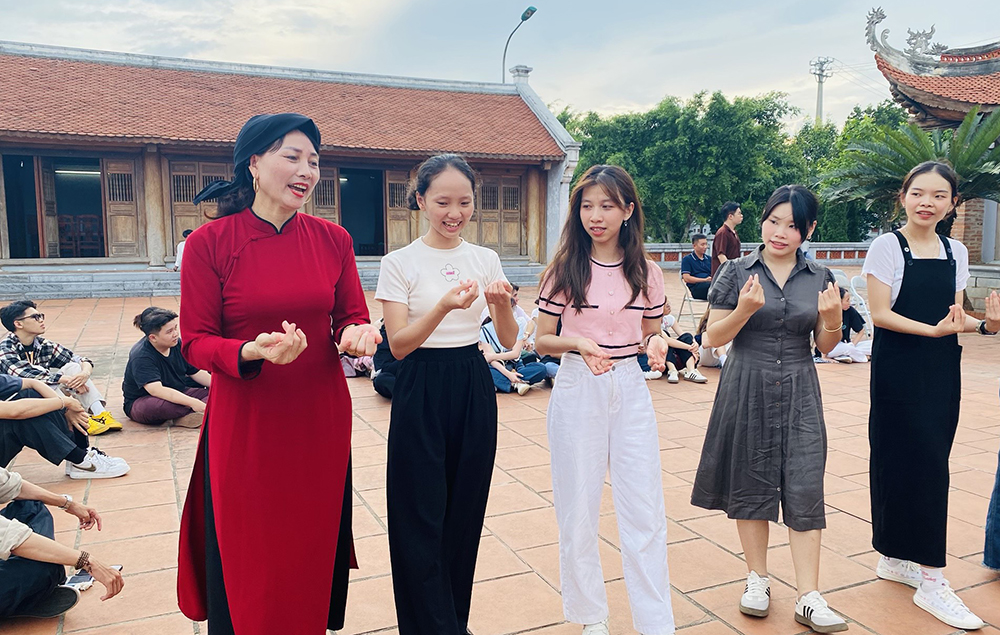Lai Len Temple, an ancient temple in Phu Duc village (Kim Duc commune, Viet Tri city), is considered the first “grand theater” of Vietnam in the Van Lang period. This is also the place where Xoan singing originated, associated with the legend of King Hung searching for land to build a citadel, and is also the original relic related to the origin of the Representative Intangible Cultural Heritage of Humanity: worship singing ritual, Phu Tho Xoan singing...
 The corner of the space displays Xoan singing art at Lai Len Temple.
The corner of the space displays Xoan singing art at Lai Len Temple.
In the minds of the people of the Ancestral Land, Lai Len Temple is a sacred place that preserves the quintessence and value of ancient Xoan melodies, and is a space for Xoan singing performances on festival occasions, especially the Hung King’s death anniversary. At the same time, the temple is also a space for students from schools in and out of the province to visit each time they organize experiential and career orientation activities.
Recently, Lai Len Temple welcomed a group of more than 100 interns majoring in Tourism and Travel Services Management, course 2021-2025, from Ho Chi Minh City University of Foreign Languages and Information Technology to visit and experience. Here, in the solemn atmosphere of the worship space, the students were immersed in the traditional art of Xoan singing. Not only listening to ancient Xoan melodies, the students also participated in performances with the artists, thereby gaining a deeper understanding of the history and meaning of this art form. The exchange helped many students feel the connection between the past and the present and, at the same time, appreciate more traditional cultural values.
Student Nguyen Thi Ha Linh shared: "Coming here, we visited the Xoan Art Heritage Exhibition House with many documents, images, artifacts, maps, scientific documentaries... and at the same time listened to the introduction and experienced to better understand the art of Xoan, the history of formation, and the existence of the Phu Tho Xoan heritage. Through that, my friends and I felt the beauty of Xoan when enjoying the performances and interacting with many artists, living in the Xoan performance space in the most authentic and vivid way... For me, this is an impressive and unforgettable experience because it will enrich my luggage and help me achieve my dream of becoming a tour guide.".
Coming to Lai Len Temple, visitors not only get to listen to and immerse themselves in the soulful Xoan melodies but also admire the photos and artifacts related to the art of Xoan. at the Xoan Art Heritage Exhibition House. This is an important highlight to help people and tourists have a complete view of this unique art form.
 Students of Ho Chi Minh City University of Foreign Languages and Information Technology were excited to experience Xoan singing performances with artists.
Students of Ho Chi Minh City University of Foreign Languages and Information Technology were excited to experience Xoan singing performances with artists.
Through the displayed images of ancient Xoan guilds in Viet Tri City, including the communal houses of Thet, Kim Dai, An Thai, Lau Thuong, and Lai Len temple, visitors have a comprehensive view of the space where Xoan singing art is transmitted. Included in the space and art of Xoan singing performances are ancient Xoan versions. These versions were previously written in Chinese characters by Confucian scholars and later translated into Vietnamese so that people could easily learn them.
The ancient Xoan songs are mainly kept and taught by guild leaders. In general, these versions have similar content, but in terms of song arrangement and lyrics, each guild has its own differences. Through more than a dozen displayed photos, visitors can also learn about the art of Xoan singing, such as the rules, order, and performance art, as well as the fruits and customs of singing in the country.
In addition to the performing arts, musical instruments and costumes used in Xoan singing are also displayed at Lai Len Temple, attracting the attention of visitors with simple musical instruments: a small drum made of jackfruit wood covered with leather on both sides, a pair of bamboo clappers, a wine jar, a four-panel shirt combined with a silk blouse, a square scarf, a scarf... scientifically arranged.
Xoan singing has crossed the cultural space of Phu Tho to reach the community of Vietnamese ethnic groups and humanity around the world and has remained a potential source of vitality for thousands of years. To make that success, we must mention the great contribution of folk artists. At the Xoan singing art exhibition space, the images of the Xoan guild leaders, who are people from families with a long tradition of Xoan singing. Some families have been guild leaders for 3 to 4 generations, passing the baton from father to son who are also placed in a solemn position.
Immersing in the Xoan singing art space has left many deep impressions in the hearts of every visitor when visiting Lai Len Temple. From there, Phu Tho Xoan singing continues to create a spreading influence in the community, demonstrating its everlasting vitality over time.
(Source: baophutho.vn)